Solar is Clean, Popular and Under Attack

Solar panel installation (SolarCity)
Let’s start with the good news.
Solar energy is growing and more popular than ever.
The amount of solar energy installed in the United States has quadrupled since 2010, generating enough energy to power 1 in 20 American homes.
In 2016, the United States witnessed its millionth solar installation and the industry expects to hit 2 million solar installations in just the next two years.
All this growth in solar power brings tangible benefits to local communities across New York.
Environmentally, solar power reduces the need for harmful fossil fuels and cuts pollution that science shows causes climate change. Here in New York, we know we need to act now to reduce the worst impacts of climate change. We already see its manifestations in hotter summers, wildfires, and more frequent extreme weather events.
Economically, solar power can lower energy bills over time as an energy source with zero fuel costs. It also creates local jobs. In 2015, solar employed over 8,200 people in New York. At the end of 2015, solar employed more Americans than the oil and gas extraction industry.
Furthermore, solar power fosters civic engagement between decision-makers and energy stakeholders, from homeowners to school principals and small business owners, creating more invested parties in the future of clean energy across New York.
Because of these benefits, solar power is tremendously popular across the political spectrum. Recent polls show that majorities of Republicans and Democrats support the advancement of clean energy.
Now here’s the bad news.
As solar power has grown, it has been attacked by entrenched energy interests who see rooftop solar as an existential threat to their bottom line.
A new report by Environment New York Research & Policy Center, Blocking the Sun, documents 17 fossil fuel-backed groups and electric utilities running some of the most aggressive campaigns to slow the growth of solar energy throughout the country.
Rather than value the full benefits of distributed solar energy, these utilities and their fossil fuel backers have attempted to cut credits to solar customers and charge them extra fees. In some states, they have even attempted to do away with renewable energy standards altogether.
The fact is we can’t maintain a status quo mostly filled with an energy portfolio of gas, coal, and nuclear power plants that threaten our environment and our health. We need to tap into solar and renewable energy sources on rooftops across New York and beyond.
Of the findings, the report documents how the Koch brothers have provided funding to the national fight against solar by funneling tens of millions of dollars through a network of opaque non-profits; the American Legislative Exchange Council (ALEC) has provided utility and fossil fuel interests with access to state legislatures and inspired anti-solar legislation in a group of states; utilities in Arizona, Florida, North Carolina, Nevada, Ohio, West Virginia, California, and Illinois have undertaken extensive campaigns to revoke renewable energy policy or impose new charges on their solar customers.
In mid-2016, there were at least 84 ongoing policy actions in U.S. states that could impact the growth of solar energy, including limitations to net metering or new charges to make rooftop solar power less economically viable.
With all the advantages of solar energy, we can’t just turn our back on tapping the power of the sun. So far, New York leaders have stood up to those who have wanted to stop progress of rooftop solar. Let’s make sure they know how much support there is for solar power and continue to push back against attempts to stunt the growth of renewable energy.
***
Heather Leibowitz, Esq. is the Director of Environment New York, a statewide advocacy organization. On Twitter @EnvNY.
***
Have an op-ed idea or submission for Gotham Gazette? Email This email address is being protected from spambots. You need JavaScript enabled to view it.
The Fight Ahead for Our City’s Homeless Children

(photo: @NYCschools)
As families across the city gather in their homes to celebrate the holidays, a record number of children -- more than 23,000 -- are currently living in homeless shelters in New York City.
Homelessness means much more than lacking a permanent place to lay your head every night, especially for children. The impacts of homelessness on young people are particularly devastating and go well beyond housing issues into health and education.
Recent local media coverage has chronicled the record high numbers of homeless students in schools throughout the five boroughs and the difficulties their parents face in meeting their personal needs and help them fulfill their academic potential. It is not that homeless students are any less capable than their peers.
Rather, the troubling disparities in performance are a direct result of the staggering barriers to physical and emotional well-being children face when they are homeless.
Citizens’ Committee for Children’s Community Risk Ranking, an annual report on children in all 59 community districts in New York City, ranks well-being across six key domains – economic security, housing, health, education, youth, family and community – and illustrates the compounding nature of risk factors. Communities that rank high-risk in one domain tend to rank high-risk in several others, multiplying the problems faced by children growing up in those neighborhoods and dramatically increasing their chances of very poor outcomes.
The risk ranking shines a light on the areas in the city that are still struggling to recover from the economic downturn, with median incomes among working poor families remaining stagnant while rents and overcrowding have continued to rise.
Such is the case in East Tremont in the Bronx, where one in three families are paying more than 50 percent of their income on rent, and families are three-and-a-half times more likely to enter the city’s homeless system than families citywide. In this neighborhood, children are not only facing obstacles in terms of housing conditions, but also regarding poor outcomes in education, health, youth risks, and crime, as well as a profound lack of economic security – all of which are proven to have a negative impact on their short- and long-term well-being.
The data is disturbing – but it also arms us with the facts we need to make sure we are comprehensively addressing children’s needs. When we know what children are up against, we are better equipped to help them and their families face the challenges head-on.
In fact, data from the Community Risk Ranking also points to communities where risks are low and children are thriving. This shows that poor outcomes can be turned around when efforts are made to ensure that New Yorkers have access to the services and supports that provide pathways to opportunities for children and their families.
We need to keep in mind both the needs of children as well as what works for them when the federal administration changes hands next month. There is no doubt that anticipated proposals would intensify the risks facing our city’s most vulnerable children.
Homeless children and their families stand to lose not only public housing or federal housing subsidies that can bring them more stability, but also many of the social safety net programs through which they receive health care coverage, food supports, or child care, and upon which their futures rely.
For example, if our city’s children lose access to the food stamps (SNAP benefits) that allow families to put food on the table for their children, the odds are great that their physical and mental health and academic performance will worsen. That is a cruel truth of poverty: Positively addressing one need does not necessarily impact others, but cutting off a resource for one need can have a devastating ripple effect.
So as we ring in the new year with family and friends, we must resolve to focus in 2017 on those more than 23,000 children who lack access to so much of what many of us take for granted. We must be ready to fight so that we have more resources to help them with, not less.
Fortunately, we have the information we need to lend our voices to children and families. We must commit to maintaining steady pressure on our federal, state, and city leaders to not only protect the programs and services these children rely upon but expand access to the services that have proven to help them thrive.
***
Jennifer March, PhD, is the executive director of Citizens’ Committee for Children of New York. On Twitter @CCCNewYork.
***
Have an op-ed idea or submission for Gotham Gazette? Email This email address is being protected from spambots. You need JavaScript enabled to view it.
The Holiday Season Opportunity to Bolster Our Local Businesses
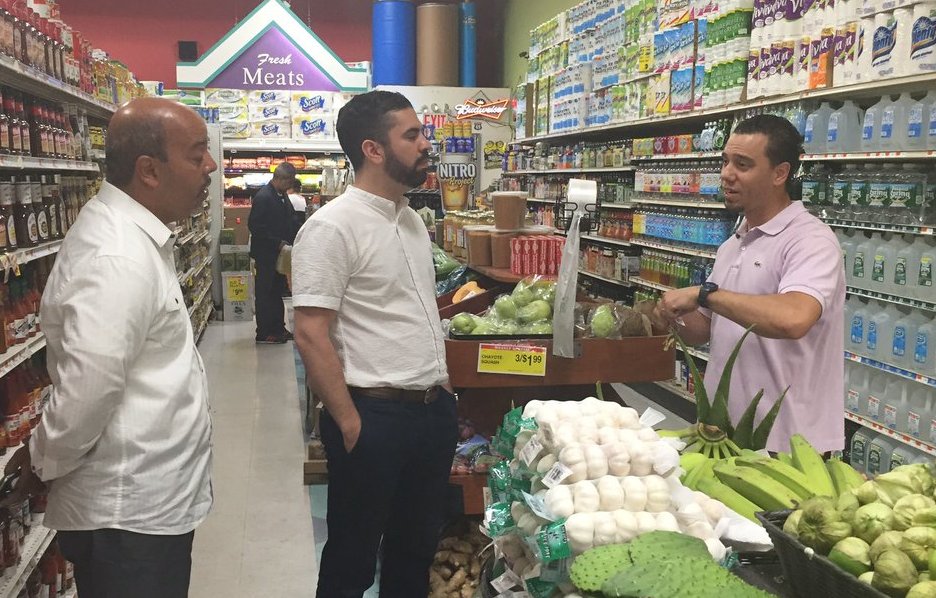
Council Member Espinal, the author (middle), tours a local market
The holidays are my favorite time of year: a time when we can open ourselves up to one another and reflect on what makes us grateful. Whether through wishing a stranger a happy holiday, participating in charity, or simply sharing traditions with friends and family, the holidays are a time for community.
Yet, amid the joy and cheer that accompany the holiday season, the pressure to find perfect gifts for our loved ones while also balancing our checkbooks can be daunting. Especially when income inequality in New York City is at an all-time high and working people are struggling to get by, the sense of obligation to buy presents is often an added burden on already financially strained families.
Even with specific family situations being what they are, New York City consumers will spend a lot of money this holiday season. We live in a heavily consumerist culture, with pressure constantly upon us to buy more and more -- pressure that is even more present during the holiday season. Whether through the temptations of often sneaky “sales” in big-box stores or more modern techniques, such as the constant slew of advertisements targeted at us on our Facebook pages or in emails, large corporations are always trying to reach us; always trying to sell us the next big thing.
Big companies often do provide us with the stuff we need to live our unique lives, while also providing jobs for our families and neighbors. But corporations do not have to be our main providers and an over-reliance on their services does not offer the best economic opportunities for our city.
This holiday season there is again an important opportunity for us to create a stronger local economy by patronizing local businesses. That is why, as a City Council member, the chair of the Consumer Affairs committee, and a Brooklynite, I am urging my fellow New Yorkers to shop locally.
Look for items made in New York to encourage local manufacturing and skip the big malls for your local business corridors. You’ll be amazed at the variety and quality of goods available to you locally, if you look.
If you prefer online shopping, consider replacing amazon.com for madeinnyc.org, an online platform that directly connects New Yorkers with local manufacturers offering the latest in food, fashion, furnishings, and other products. There's nothing like shopping local for all your last-minute gifts, too.
One recent study found that for every $100 spent at a local business, $68 stays in the community. Yet, when the same amount of money is spent at a non-local business, it produces only $43 for the local community. That difference of $25 per $100 could be going to community businesses, which are often owned by families and employ neighborhood folk. Local ‘mom and pops’ have long been the backbone of our society -- they sustain families and provide jobs to community members. In fact, since 1990, small businesses alone have created 8 million jobs and most owners support paying above and raising the minimum wage.
These are key reasons to shop local this holiday season -- and beyond.
Small businesses no doubt contribute to the economic fabric and sustainability of our local communities. And, if that is not reason enough to support your local shops, consider this: a Harvard Business School Study found that CEOs make 350 times more than the average worker. Income inequality is one of the most crucial and wide-reaching issues of our day. We saw this as a major theme in our recent presidential election, both in the Democratic primary between Hillary Clinton and Bernie Sanders and in the general election with the nomination of Donald Trump -- a radical rejection of the political status quo -- because it spoke to many Americans’ innermost economic and social grievances.
Each of us has ample opportunities to make personal choices that hold large corporations accountable and bolster our local businesses. As chair of the City Council Committee on Consumer Affairs, and as a proud Brooklynite, I urge New Yorkers to spread the cheer to their local retailers and shop locally this holiday season.
***
Rafael Espinal is a New York City Council member representing parts of Bushwick, East New York and Oceanhill-Brownsville in Brooklyn. As Chair of the Committee on Consumer Affairs, Council Member Espinal works to enact legislation that protects consumers, strengthens businesses, and empowers New Yorkers. On Twitter @RLEspinal.
***
Have an op-ed idea or submission for Gotham Gazette? Email This email address is being protected from spambots. You need JavaScript enabled to view it.
CUNY's Insufficient Response to Military Veteran-Students
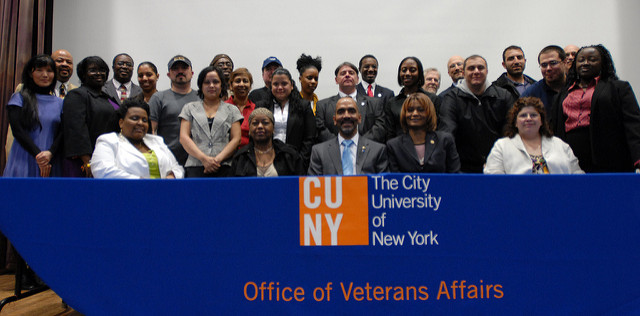
photo via CUNY
The December 8 response from CUNY’s Interim Vice Chancellor Christopher Rosa to Joe Bello's Gotham Gazette op-ed of the day prior surprised many student-veterans on CUNY campuses -- including the ten signatories of this letter.
To begin with, we were not aware that CUNY actually recruits veterans to its campuses, as IVC Rosa asserted. From our experience, military veterans usually attend a CUNY school based on a campus location or a school’s specialization - degree programs, specialty programs like Veterans Upward Bound - and, most importantly, word of mouth from other veterans. None of us have seen any recruitment directed at veterans, either through advertising or social media, at our prior military commands or when we came to New York City.
Also, while CUNY does waive our application fees, it is not clear to us who are the “deployed, dedicated admissions counselors” who supposedly smooth our way through admission. For many, admission into the CUNY system is a long and arduous process and at no time did we meet counselors “deployed” to help us. If anything, many of us were referred to CUNY’s admissions website for veterans.
With regard to IVC Rosa stating that CUNY works to "assure that New Yorkers eligible for the Post 9/11 GI Bill attend 100 percent cost-free," the U.S. Department of Veterans Affairs pays our tuition to the campuses based on our length and type of military service. This means that not every student-veteran, or eligible dependent, utilizing tuition assistance from the Department of Veteran Affairs is attending without a financial burden.
Furthermore, we question IVC Rosa’s statement that the “veterans services coordinators are a one-stop resource to support veterans in their transition from military life to higher education.” As Mr. Bello stated in his op-ed, Baruch College does not have a coordinator and other CUNY campuses currently have issues of harassment, alienation, and unresolved complaints lodged with their respective coordinators. These issues, as well as others on CUNY campuses, have led many student-veterans to help themselves to find the resources to support them in their transition.
Lastly, on IVC Rosa’s statement that CUNY was the first university system in America to be named “military friendly” by Victory Media: as several people testified at the November 15 City Council hearing, any college can obtain this designation by filling out a form that Victory Media provides. Case in point, over three semesters LaGuardia Community College has been engaged in a dispute with its student-veterans regarding their current coordinator, yet the school still received the “veteran friendly” designation, and even as that college’s student-veteran enrollment numbers have decreased. There seems to be no real mechanism in place by either Victory Media or CUNY to really know which institutions deserve the designation and which don't.
IVC Rosa states that “external rankings validate the welcoming environment at CUNY colleges for those who have served their country.” However, as individuals who have served this country and are currently pursuing degrees within the CUNY system, we have to ask: When will the ongoing battles of CUNY’s student-veteran population begin to be addressed by the leadership at CUNY?
IVC Rosa's letter appeared to be nothing more than an attempt to put a stop to the discussions that are currently going on between CUNY and its student-veterans, and his letter does not address the issues raised by Mr. Bello in his op-ed.
We want IVC Rosa and CUNY leadership to understand that while they state that CUNY cares about its student-veterans, many campuses do not have the necessary resources to allow our successful transition from military to higher education. Therefore, we are demanding that the Board of Trustees and CUNY leadership take action to make CUNY live up to its “military friendly” designation. If not, then all that we -- as skilled, hard-working and experienced student-veterans -- bring to our CUNY campuses, including our federal dollars, can be taken elsewhere.
Trent Coyle
US Army, Baruch College
Sungin Hong
USMC, Baruch College
Melissa Siew
USMC, Baruch College
Christian Espada
US Army, Bronx Community College
Margie Guzman
US Army, Bronx Community College
Noah Almonor
US Army, City College
Ishmael Shalom
USMC, John Jay College
Bryan Williams
USCG, John Jay College
Kevin Chimilio
USMC, Lehman College
Ricky Malone
USCG, Queens College
***
Have an op-ed idea or submission for Gotham Gazette? Email This email address is being protected from spambots. You need JavaScript enabled to view it.
Observing Homeless Persons’ Memorial Day & Committing To End It

2015 Homeless Persons’ Memorial (photo: Care for the Homeless)
Today, Wednesday December 21, advocacy and social justice organizations in cities across the country gather together to observe Homeless Persons’ Memorial Day. This annual remembrance is held on winter solstice. It’s fitting this solemn occasion is scheduled for the longest, darkest night of the year, because each night without housing is long, dark and cold.
In New York City, where the number of people experiencing homelessness is at its all-time high, there will be several observances. The NYC Providers of Health Care for the Homeless held one last week. Picture the Homeless will hold a program at Judson Memorial Church today, Wednesday, at 6 p.m.
Today at 5 p.m., our organizations -- Care for the Homeless and Urban Pathways -- will hold an observance at Drisha Institute for Jewish Education, on West 65 Street. The program, which is free and open to the public, will feature currently and formerly homeless clients reading the names of and eulogizing those who experienced homelessness who died in New York City this year. As each name is read a bell will toll, a candle will be lit, and information about the deceased will be projected on a screen.
Many that we remember during homeless persons’ memorial programs would not be memorialized without such gatherings. But we know and remember that each individual, regardless of their housing situation, has value and dignity. People are more than the labels we assign them, including that of homeless. Homeless Persons’ Memorial Day provides an opportunity to recommit to the value of all people, including those who have experienced or are experiencing homelessness, and to our fight to end homelessness.
Many that we memorialize have died prematurely. A crucial component of health and well-being is stable housing. Compared to the general population, people who experience homelessness are at greater risk of chronic and infectious illness, mental health challenges, and substance abuse. They are also more often victims of violence. According to the Center for Disease Control and Prevention, homeless persons’ mortality rate is four to nine times higher than those not homeless.
It doesn’t have to be like this. We can end homelessness by focusing on and implementing wise policies. In addition to remembering those who have died, often needlessly, Homeless Persons’ Memorial Day serves to remind us that we have cost-effective solutions to homelessness. The key is supportive housing, which we need to develop now and allow nonprofit organizations to operate to the best of their abilities. We also should employ those experiencing homelessness in outreach programs, shelters, and supportive housing residences. Their lived experiences are valuable, and the opportunity for employment is invaluable.
The time is now to answer the prayer of each Homeless Persons’ Memorial Day program in the 170 cities across North America. One winter solstice, there will be no need to observe Homeless Persons’ Memorial Day.
***
Jeff Foreman is Policy Director at Care for the Homeless. Nicole Bramstedt is Policy Director at Urban Pathways. Both organizations serve homeless adults in New York City. On Twitter: @UrbanPathwaysNY & @CFHNYC.
***
Have an op-ed idea or submission for Gotham Gazette? Email This email address is being protected from spambots. You need JavaScript enabled to view it.
The Specialized High School Exam: A Flawed Test in a Flawed System
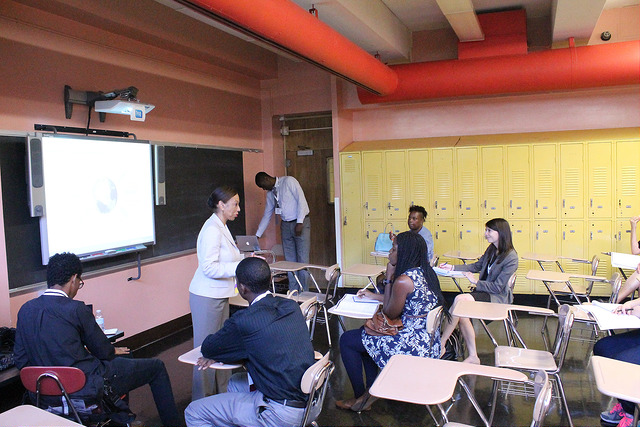
(photo: Kevin Caraballo for the DOE)
Every October, roughly one-third of the eligible eighth-graders in New York City -- between 25,000 and 30,000 students -- take the Standardized High School Admissions Test (SHSAT) for a chance to attend one of the city’s eight specialized high schools. Admission to these schools is highly competitive, and spots are coveted. While less than 20% of students who take the test receive an offer, 72% of those who are accepted choose to attend. Yet, despite being in New York City, where the overall student body is 72% black and Hispanic, students of color make up only 12% of specialized high school students, a number that is declining.
This is due to a flawed and exclusionary education system that negatively affects low-income students and students of color from their first day in the system. In New York City, the clear majority of students are assigned elementary schools that are within their zip codes. For many students of color, this means that they attend schools that face a myriad of problems, including: less funding and resources, less experienced and effective teachers and overcrowded classrooms. This, in addition to the various socio-economic problems that students from these backgrounds already face in their daily lives. Ultimately this results in students from these backgrounds having lower attendance rate, lower grades in key subject areas and lower standardized scores.
Next, because entry to middle school is based on those aforementioned metrics, low-income students and students of color are substantially less likely to attend honors or screened programs. Instead, these students attend schools within their zip codes, which face the same issues that elementary schools face. And, analysis shows that between 2005 and 2013, 88 middle schools, 76 of which were honors or screened, were home to 85% of total student offers to SHSAT schools. Demographic data further revealed that students from these schools came from wealthier, and largely white or Asian households.
In addition to the socio-economic advantages that students who enroll into these strong middle schools typically have, they also benefit from attending the schools themselves. Not only are these schools better funded, they also offer more comprehensive and rigorous curricula. Importantly, these schools also dedicate resources to informing students and parents about the SHSAT, and the high-school admissions process in general.
A natural consequence of attending one of these schools is that students and parents are both more likely to have heard of the SHSAT and students are more likely to be prepared to take the exam. It is here that the inequities in the system become reinforced, adversely impacting students in two key ways: first in deciding to take the SHSAT and subsequently, in earning the requisite admission score.
Yet, it would be a mistake to assume that the SHSAT itself is color- or income-blind. Analysis reveals a flawed exam. Like all standardized tests, critics argue that the SHSAT does not test for ability and potential.
Rather, the test is basically an indicator of income and narrow readiness more than anything. Parents who can afford to invest in expensive preparatory courses and high quality private tutors to give their children an advantage -- often added upon prior advantages. Test-prep companies and private tutors are keenly aware of how the test works and impart significant help. Two notable examples of this include:
1. The SHSAT’s decision to favor higher overall scores, rather than balanced ones. This means that a student with a score of 500 (with a score breakdown of 250/250) is viewed less positively than a student who scores a 501 (with a score breakdown of 399/102) – where the lowest score a student can get on a section is a 100, and the highest a 400.
2. In addition, students who prep generally take several simulated SHSATs under test conditions. Since the SHSAT is administered only once per year, students who receive this preparation are much more prepared, psychologically and otherwise, than those who are taking the exam without having practiced a simulation.
Criticisms of the SHSAT are not solely socio-economic. Two reports that examined the SHSAT found that “Students who receive certain versions of the test may be more likely to gain admission than students who receive other versions” and that “the SHSAT ignores widely accepted psychometric standards and practices.” Psychometric standards are evaluations that test for reliability and validity.
In addition, because the cut-off scores for admissions differ slightly from year to year, being accepted on the margins is largely a matter of luck. And finally, the SHSAT only tests for ability in math and reading, other key subjects, such as science and social studies, are not included.
Ultimately, the SHSAT, and the educational system that it sits within, is deeply flawed. Policy changes must be considered to make the system more equitable.
***
Bernard Agrest is a recent graduate of the University of Edinburgh's MPP with a focus on education policy analysis.
***
Have an op-ed idea or submission for Gotham Gazette? Email This email address is being protected from spambots. You need JavaScript enabled to view it.
Bias in New York Prisons Requires a Blue Ribbon Commission Investigation
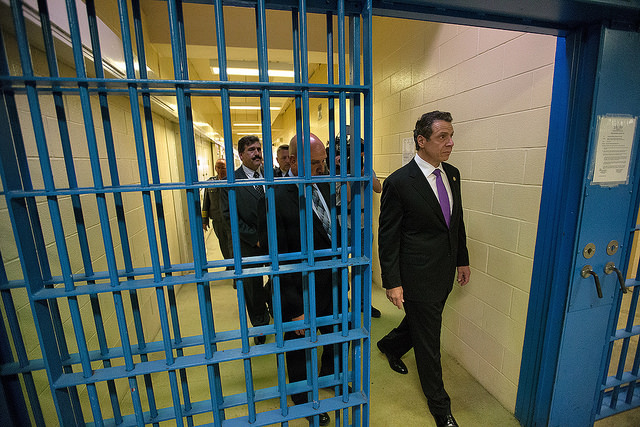
Gov. Cuomo on a prison tour (photo via Governor's Office on flickr)
According to The Sentencing Project, New York State has led the nation by reducing its prison population by 26 percent between 1999 and 2012, while the nationwide state prison population increased by 10 percent. During these years of decarceration, violent crime rates fell at a greater rate in New York than national averages.
Yet, despite New York’s lead in simultaneously decarcerating its prison system and reducing crime, racial disparities throughout New York’s criminal justice system remain unchanged.
Recent investigative reports by The New York Times show how racial bias is infecting New York State prisons. The paper’s investigation found that black people in prison are punished at significantly higher rates than whites, sent to solitary confinement more often, and detained longer.
In response, Governor Andrew Cuomo directed the state inspector general to investigate these “allegations” and recommend appropriate reforms for immediate implementation.
This is not enough.
Governor Cuomo must use his executive power to create a diverse, non-partisan Blue Ribbon Commission to investigate the widespread racial bias throughout New York State’s criminal justice system.
The commission’s independent investigation should go well beyond rooting out structurally racist practices in our prison and parole systems. It should undertake a comprehensive review of the state’s entire criminal justice system, from arrest to reentry, within a definitive timeline.
JustLeadershipUSA believes that those closest to the problem are also closest to the solution, but furthest from the resources and power. To that end, the governor must ensure that the commission includes formerly incarcerated leaders. The commission also should represent the interests of the gamut of other people and groups that interact with the criminal justice system— prosecutors, judges, police and correction officers, people in prison, defense attorneys, advocacy groups, think tanks, victims’ rights organizations, and academics.
After convening, reviewing practices and policies, listening to stakeholders, hearing from experts, and problem-solving for 12 months, this commission should then make recommendations for criminal justice reform to the governor and state Legislature, and disseminate its findings to the public.
In addition to appointing a Blue Ribbon Commission, the governor should use his executive power immediately to address the issues of parole and solitary confinement. With regard to parole, Governor Cuomo should:
- Nominate more professionally, racially, and geographically diverse parole board candidates who more accurately represent the New York communities most impacted by crime and incarceration.
- Increase transparency by publicly releasing data annually to provide clarity into parole decision-making.
- Increase bandwidth of parole board members to ensure that cases are reviewed in person and with the thoughtfulness they deserve.
To truly address the issue of solitary confinement, Governor Cuomo should create a timeline for discontinuing the use of all solitary confinement and punitive segregation throughout the state prison system. He should also direct the state Department of Corrections and Community Supervision (NYSDOCCS) to immediately ensure that far fewer people are placed in solitary confinement.
And if people are sent to solitary, at the very least conditions and health care should be improved, time spent in solitary should be reduced, and detainees should receive a clear path, based on achievable goals, to earn their way out of solitary.
We will not dismantle hundreds of years of racial bias and discrimination in our criminal justice system in a vacuum. Instead, we must collaborate and engage with impacted people from varying walks of life.
If Governor Cuomo is truly committed to creating systemic change, the creation of a nonpartisan Blue Ribbon Commission is critical to uncovering the disparities in our prisons and our broader criminal justice system and identifying and implementing solutions. Together, we can work toward restoring a historically broken and racially inequitable system.
***
Glenn E. Martin is the founder and president of JustLeadershipUSA (JLUSA), a national organization dedicated to cutting the U.S. correctional population in half by 2030. JLUSA empowers people most affected by incarceration to drive policy reform. Martin is a national leader and criminal justice reform advocate who spent six years in New York prisons. He is the recipient of the 2016 Robert F. Kennedy Human Rights Award. On Twitter @GlennEMartin.
***
Have an op-ed idea or submission for Gotham Gazette? Email This email address is being protected from spambots. You need JavaScript enabled to view it.
In Trump Era, Workers Will Demand New York City & State Step Up to Defend Them
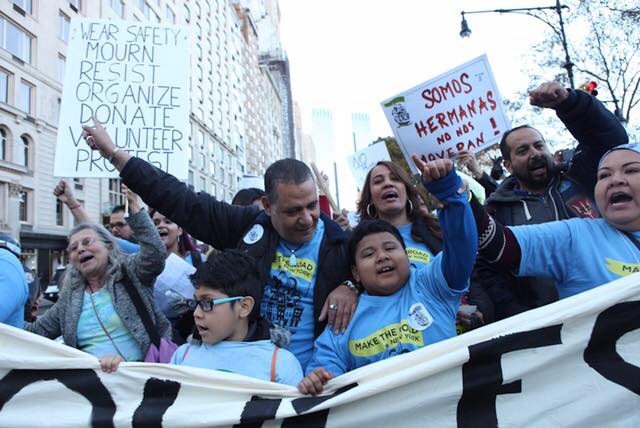
photo: Make The Road New York
The symbolism of Donald Trump’s nomination of fast-food CEO Andy Puzder for U.S. Secretary of Labor could not be clearer: at a time when fast food workers are leading the fight for fair pay and dignified working conditions in this country, President-elect Trump has decided to declare war on the Fight for $15 movement. And here in New York, workers like me are ready to fight back.
Puzder has fought attempts to raise the minimum wage, argued against expanding eligibility for overtime pay, and supports repealing the Affordable Care Act. At a time when corporations have been working hard to fight minimum wage increases and roll back workers’ rights through forced arbitration of employee grievances, misclassifying workers, and automation, they could find no better ally in harming workers than Puzder.
Like President-elect Trump, Puzder peddles his preferred policies as trickle-down-economics: more money for CEOs equals more jobs for working people. But these ideas have been discredited for decades -- they’re the reason that wages for workers like me have stagnated for so long. And, they’re rooted in the offensive assumption that some people -- service workers, immigrants, and people of color -- deserve to live in poverty no matter how hard they work, while corporate CEOs deserve to get rich off their labor.
A Puzder appointment is bad news for all working people, but the situation is even more precarious for immigrant workers, who already experience on-the-job exploitation like wage theft at triple the rate of the rest of the workforce. A CEO-led Department of Labor, coupled with the nativist agenda of Donald Trump, sends a clear message to employers to ramp up a strategy they have long-used to try to subjugate immigrant workers: weaponizing immigration status to retaliate and intimidate.
Immigrant workers in New York have been leading the labor movement for decades, most recently winning historic increases in the state minimum wage, some of the strongest legal protections against wage theft in the country, and collective bargaining rights in industries, like carwashes, considered “unorganizable.” We remain ready ready to fight, but we will need energetic allies in our city and state governments and creative new strategies to ensure that we protect against the worst of what comes out of Washington, D.C. and continue to win victories closer to home.
First on the agenda will be making sure that the state’s $15 minimum wage victory becomes a reality for all New Yorkers, especially those who will be most vulnerable during a Trump presidency. This means shortening the timetable for reaching $15 upstate, raising tipped workers to the full minimum wage, and implementing new strategies for combating wage theft and employee misclassification. Workers, especially low-wage workers, also need fair scheduling rights in order to better plan their lives and support their families; legislation has been introduced at the City level and should be explored throughout the state.
There’s an old labor movement saying that sometimes management is the best organizer, meaning a bad boss can be the best incentive to organize. While working people in New York, and throughout the country, certainly have our work cut out for us under a Trump administration, Andrew Puzder’s offensive agenda could make him our best organizer yet. We will fight, and we will win.
***
Daniel Cortéz is a member of Make the Road New York (MRNY), which, with New York Communities for Change, is hosting a workers’ forum with leading government officials on Wednesday, December 14 at 7pm at New York Law School to discuss how to defend economic security for immigrant workers under the Trump administration.
***
Have an op-ed idea or submission for Gotham Gazette? Email This email address is being protected from spambots. You need JavaScript enabled to view it.
‘Done Deal Democrats’ Push Misguided Land Grab

photo: Friends of Roosevelt Park
New York City is ruled by political elite, based in the Democratic Party. Elected officials regularly run unopposed or win re-election by margins that approach those of one-party regimes. They nominate and appoint community board members. They endorse each other’s re-election. They co-sponsor bills, attend party fundraisers, and work together to restrict the citizenry’s right to be heard and influence policy. Nowhere is this anti-democratic approach clearer than in the case of the American Museum of Natural History’s planned annexation in Margaret Mead Green and Teddy Roosevelt Park.
The museum, a private institution, wants to erect a giant, gas-fueled building in a public park. And, its “done deal” allies in government are all-too-willing to help them. For a year, the Manhattan borough president, the local City Council member, the community board chair, the city comptroller, the local Assembly member, and the city parks commissioner have told everyone that the project was, “a done deal.” Without a public hearing, before any community board dialogue, these “representatives” spread the word that the annexation was a forgone fact.
However, park preservationists, environmentalists, educators and neighbors have objected. They describe the plan as toxic, because, well, the museum wants to build on top of a toxic waste site and because it would spew millions of metric tons of carbon dioxide into the air. More than 4,000 people have picketed and signed petitions arguing against this eco-cide. They’ve pointed out that the neighborhood is already glutted with cultural institutions (e.g. Lincoln Center, the Historical Society, the Manhattan Children’s Museum) while other neighborhoods suffer a lack of cultural resources (The Bronx has only two museums for a borough of 1.5 million people.).
Those who live closest to the site worry about an additional 800,000 people each year flooding the tiny park’s pathways to gain access to a new gift shop, restaurant, and event space. Finally, everyone became outraged when a local journalist revealed that the Done Deal Democrats had appropriated nearly $100 million of taxes for this project.
Opponents of the plan went to Community Board 7 to urge its neutrality and to request that information from both sides of the issue be placed on the board’s website. Instead, the only material that appeared was provided by the museum, which wrote glowingly about its own proposal. For nine months, opponents of the plan asked the board to hold a public hearing before the city budget was approved and millions more allocated. Instead, the board officially joined a “working group” organized by and at the museum, so it could work out the kinks of the plan’s implementation.
And, when the community board finally got around to holding a hearing on the plan, the museum was allotted 45 minutes to make its case while opponents were given one minute each.
How has the museum been able to secure such enthusiastic support for this project from these public servants? Why have all these government officials been so generous with our tax dollars? In a word, lobbyists.
The museum has hired at least half-a-dozen lobbying firms to ply millions from our state and local treasuries. Seems surreal but true: public servants giving a private institution an enormous sum of our money to plunder our public asset, Teddy Roosevelt Park. The process is well-documented on the website of the state’s Joint Commission on Public Ethics (JCOPE) and OpenSecrets.org. One firm is hired to influence the borough president, the mayor, the comptroller and the City Council. Another is hired to lobby government officials at the state level. And, yet a third set of influence-peddlers work on the federal level.
In an age when cities around the world are striving to reduce greenhouse gases, our city is indulging this fossil foolishness of the museum’s expansion. In an era when citizens are manifesting a gross distrust of government, New York City is operating like an autocracy. And, in a neighborhood rife with segregation and inequality, these Done Deal Democrats are reinforcing those disparities.
In the names of Teddy Roosevelt and Margaret Mead, we can do better.
***
Dr. Cary Goodman has lived on the Upper West Side for four decades and has been active in the community throughout.
***
Have an op-ed idea or submission for Gotham Gazette? Email This email address is being protected from spambots. You need JavaScript enabled to view it.
Building in the Wrong Places: A Pivotal Choice
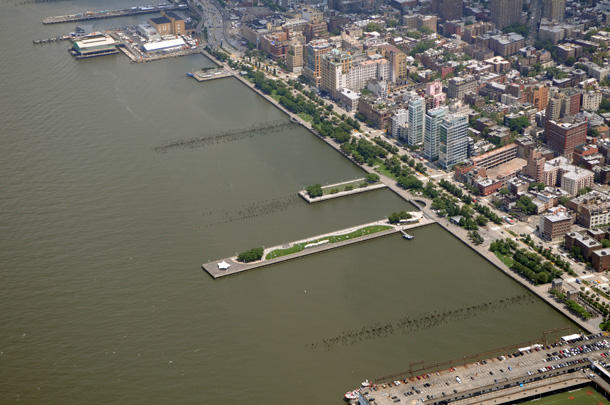
photo: Hudson River Park Trust
Building sites for so-called "parks" or other misplaced uses in or over the water offshore is a ruinous policy. Unprecedented proposals now before the City Council to help finance such in-water construction by selling legally dubious "air rights" (supposedly unused development rights) from sites in the lower Hudson River--starting with Pier 40--or other public waterways to mega-developers would magnify this harmful policy's potentially catastrophic citywide impacts.
Joanne Witty's Dec. 2 op-ed contained misrepresentations used by both the Hudson River Park Trust (HRPT) and the Brooklyn Bridge Park Corporation to market the in-water parts of these public authorities' projects. In both cases, the green space on dry land under their purview is genuine parkland. But the real estate these authorities plan to keep rebuilding in the water in the guise of a park is not.
The public waterway in the lower Hudson River--the natural resource now under the gravest immediate threat--is not a "park.” The River's priceless nearshore waters are the worst possible place to build or rebuild real estate for any non-water-dependent use. The 490 acres of open waters and piers and other structures under HRPT's jurisdiction are in a #1 (highest risk) hurricane evacuation zone, so building sites to attract more people to the river at that location puts too many people in harm's way in deadly storms. These waters are also an irreplaceable aquatic habitat for living marine resources, including valuable coastal fisheries. And the river's open waters are a treasured public open space resource for many thousands of New Yorkers.
Some good reporting on the risks to human life and property from building real estate offshore followed right after Superstorm Sandy, but since then too many investigative reporters have been asleep at the switch. The staggering risks to public safety from Hudson River development are matched only by the risks to city finances and to sensible public spending priorities, since under disastrous 2013 state legislation city and state taxpayers would be on the hook for storm and hurricane damage costs and liability claims and disaster recovery costs -- potentially billions of dollars worth, based on Superstorm Sandy.
Stealth 2013 amendments to the Hudson River Park Act approved when now-convicted State Assembly Speaker Sheldon Silver and Senate Majority Leader Dean Skelos were still in office shifted massive financial risks to taxpayers. This appalling package of 2013 amendments also paved the way for this week's "air rights transfers from the Hudson River" City Council proposals (LU 0506-2016 and related actions).
None of the Council's large staff had made timely, accurate information about these complex proposals public before crucial Council subcommittee and committee actions Dec. 5, despite an outpouring of opposition from Sierra Club, Clean Air Campaign, Friends of the Earth, and other activists. If the full Council approves and signs off on unprecedented, legally dubious "air rights" transfers from public waterways on Dec. 15, high-risk, complex financing schemes are likely to follow.
For what purpose? To implement a budget-busting, legally dubious, environmentally destructive, astronomically expensive 1960s policy that would unleash totally avoidable risks on New Yorkers today—along with swarms of “air rights” poised to land on any neighborhood where politicians want to make a deal to misuse our air, water and land.
That policy (building and rebuilding in-water development sites offshore) should be firmly rejected by any City Council member who values public safety, disaster prevention, genuine sustainability and resiliency policies that work, and fairer, wiser city spending priorities.
***
Marcy Benstock is executive director of Clean Air Campaign and its Open Rivers Project. Clean Air Campaign shares the website www.WestwayThenandNow.org with other groups.
***
Have an op-ed idea or submission for Gotham Gazette? Email This email address is being protected from spambots. You need JavaScript enabled to view it.
Letter: CUNY is Committed to Educating Military Veterans
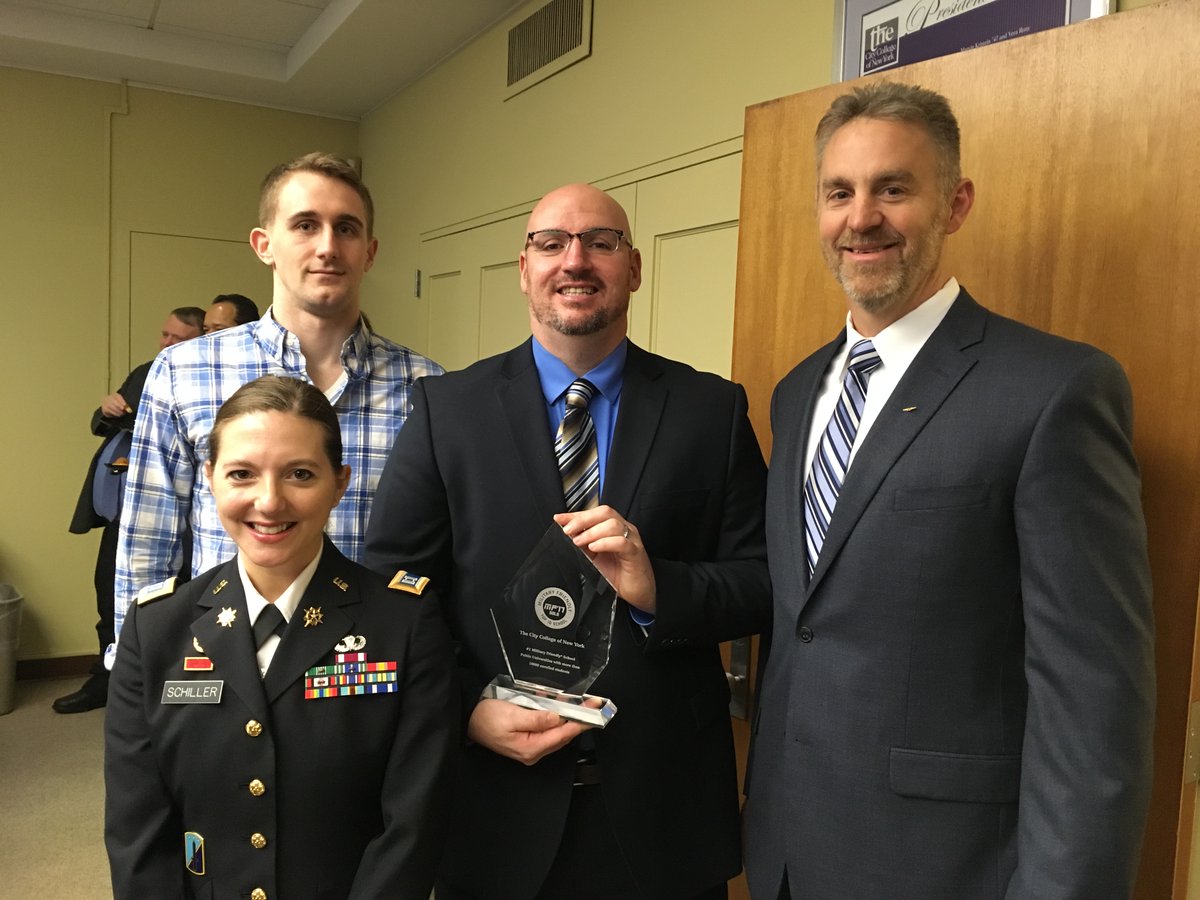
CUNY has earned praise as "military friendly" (photo via CUNY)
Dear Editor:
Regarding Joe Bello’s Dec. 7 op-ed, CUNY is deeply committed to making our University a first-choice destination for veterans. We proudly educate more than 3,000 student veterans, up more than 250 percent over the last eight years. We recruit veterans; deploy dedicated admissions counselors who smooth their way through admission; waive their application fees; assure that New Yorkers eligible for the Post 9/11 GI Bill attend 100 percent cost-free, and offer in-state tuition to non-New Yorkers for their first 18 months of study. We also proactively review veterans’ Joint Service Transcripts to grant academic credit for military service. Our campus veterans’ services coordinators are a one-stop resource to support veterans in their transition from military life to higher education.
Earlier this year the City University of New York became the first university system in America to be named “military friendly” in recognition of its programs for veterans, members of the armed forces leaving the service, and their military spouses. City College was just named the nation’s number one military-friendly large public college. We are proud of these designations for CUNY and City College, which affirm our progress toward cultivating and sustaining a university that embraces and empowers student veterans.
External rankings validate the welcoming environment at CUNY colleges for those who have served their country. That said, more funding for veterans’ programs would certainly be most welcome, and we look forward to working with the City Council for additional support. In the meantime, CUNY colleges will continue to make the best of available resources to assist student-veterans wherever possible.
Sincerely,
Christopher Rosa
Interim Vice Chancellor for Student Affairs
City University of New York
***
Have an op-ed idea or submission for Gotham Gazette? Email This email address is being protected from spambots. You need JavaScript enabled to view it.